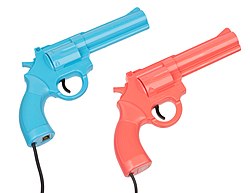Models
The Genesis and Super NES versions of the Justifier light gun were modeled after the revolver-shaped light gun controllers employed by the original Lethal Enforcers arcade game cabinet. The blue Justifier gun connects directly to the console. Optionally, a pink Justifier can be daisy chained into the blue gun for use by a second player. [1] The pink Justifier was sold separately and is compatible with both the Super NES and Genesis models of the blue gun through a 6-pin RJ-11 phone cord. Konami opted to design its own light gun peripheral for the console versions of Lethal Enforcers, instead of supporting the first party Super Scope and Menacer light guns, in order to provide a more accurate reproduction of the arcade game at home. In Japan, the Super Famicom version of the light gun was sold as the Model 510, while the Mega Drive model kept "The Justifier" branding used overseas.
The PlayStation version of the light gun (Sony ID: SLPH-00014, SLEH-00005, SLUH-00017), sold as the Hyper Blaster in Japan and Europe, is colored green (with the Japanese model being black). The Hyper Blaster was also the first light gun for the PlayStation, preceding the release of Namco's GunCon by a few years. Project Horned Owl , a gun-shooting game published by Sony Computer Entertainment, was the first title to support it. [2] The Hyper Blaster and the GunCon were mutually incompatible, although some games, such as Elemental Gearbolt , supported both peripherals. Additionally, some third-party lightguns were produced that support switching between Hyper Blaster and GunCon modes. [3]
This page is based on this
Wikipedia article Text is available under the
CC BY-SA 4.0 license; additional terms may apply.
Images, videos and audio are available under their respective licenses.
